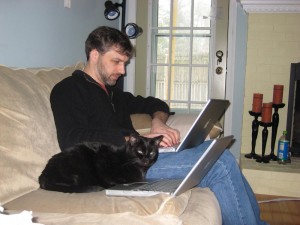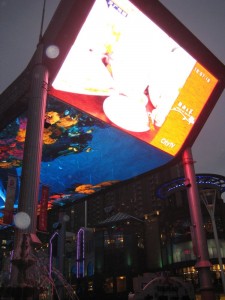Archive for the ‘Technology’ Category
Geeks
Sunday, February 14th, 2010Home improvements
Tuesday, February 24th, 2009When you pull a fleece blanket off in the dark and all you see is blue static electric, other than being very cool to look at you know you might have a humidity problem.
Our house runs on a heat pump system, which in the summer sucks the hot air out, and in the winter goes into to reverse to suck cold air out. One of the side affects of doing this is that that it also pulls all the moisture out of the air which is a good thing in the summer and a bad thing in the winter.
We have been running a standalone humidifier since last Christmas but the cats were starting to avoid us since they would get little shocks every time we touched them. After being out in a cabin for the long weekend I decided to come home early and install a whole house humidifier. After 2 trips to Home Depot I had a Honeywell HE360A whole house Humidifier and almost everything I needed to do the install. Our house used to have a humidifier and I am not quiet sure what possessed the previous owners to remove it, but it was gone, but they left nice starting holes for fitting the new one. After a couple hours of cutting, drilling, running thermostat cable, spraying my self with water, I had it installed, and the house was sitting at about 30-40% humidity.
The only problem was the humidifier was a running all the time not just when the heat pump was running. After a bit of research I found I needed a A50 24v current sensing relay. Surprisingly this isn’t something that Home Depot or Lowes stock so I had to order it online. It came last night in the mail last night and after some more unscrewing, twisting and rerouting I have it installed and everything it works!
The house is continuing at about 35% humidity, the heating appears to be running less frequently, and the cats are a lot happier. It will be interesting to see how it affects our electricity bill, but we are ever hopeful.
bash geeking
Wednesday, January 14th, 2009I am archiving my photos onto DVD’s so I thought I would be smart and create MD5 sums of the files so I could verify the DVD is still good. Except I screwed up a little. The files I created contained the following
MD5 (./034/DSC_4109.JPG) = 294b6282bfcaca127f680d88240d4192
So I had to do a little bash scripting to split the file and then compare the files, this is what I came up with
for a in `ls *.JPG`; do export MD5=`md5 -q $a`; export MD52=`cat $a.md5`; MD53=${MD5#*=}; if [ $MD5 == $MD53 ]; then echo "$MD5 $a good"; fi; done
So what should i do…..
Wednesday, January 7th, 2009So what should i do…..
My phone keeps locking up, not the sporadic rebooting I have come to live with in return for not being ensnared by windows mobile’s need to use a stylus for everything.
Instead it just hangs somewhere between 1xrtt and EVDO, no calls, no data, no email till I turn the radio on and off.
Should I kick the phone to the curb, and let it be another victim of Palm OS which has been due for replacement for years?
Should I try upgrading the firmware to that final verizon patch I have been ignoring?
Should I persevere and wait to see what palm is coming out with their New-ness announcement tomorrow in the hope that version 1 will be bug free and stable.
Or do I give the finger to verizon and go get an android G1 phone, with all its openness but with that uncomfortable right hand bump out when typing on the keyboard.
Network Speeds
Sunday, January 4th, 2009Last night I needed to transfer a vmware image from a linux host to a windows laptop. I was surprised it took over an hour to do so considering it was on a wired network, so I decided to do some testing on my network.
I have two ubuntu linux hosts which I will be calling linux1, linux2. I also have a mac laptop (apple1), a windows laptop (win1), plus a windows vm running on the mac (win1-vm). All have onboard gigabit network interface cards and are connect to a single 10/100 24 port switch in the basement.
So the first thing to do is benchmark the network and get a baseline
linux1 to linux2
linux1:$ iperf -t 60 -c linux2
------------------------------------------------------------
Client connecting to linux2, TCP port 5001
TCP window size: 16.0 KByte (default)
------------------------------------------------------------
[ 3] local 10.1.1.50 port 45045 connected with 10.1.1.136 port 5001
[ 3] 0.0-60.1 sec 674 MBytes 94.1 Mbits/sec
and apple1 to linux2
apple1:$ iperf -t 60 -c linux2
------------------------------------------------------------
Client connecting to linux2, TCP port 5001
TCP window size: 129 KByte (default)
------------------------------------------------------------
[ 3] local 10.1.1.125 port 64143 connected with 1.1.1.136 port 5001
[ ID] Interval Transfer Bandwidth
[ 3] 0.0-60.0 sec 664 MBytes 92.9 Mbits/sec
Here is the output from the endpoint linux2
linux2:$ iperf -s
------------------------------------------------------------
Server listening on TCP port 5001
TCP window size: 85.3 KByte (default)
------------------------------------------------------------
[ 4] local 10.1.1.136 port 5001 connected with 10.1.1.50 port 45045
[ 4] 0.0-60.2 sec 674 MBytes 93.8 Mbits/sec
[ 5] local 10.1.1.136 port 5001 connected with 10.1.1.125 port 64143
[ 5] 0.0-60.0 sec 664 MBytes 92.9 Mbits/sec
This gives us a baseline of 92.9 Megabits to 93.8 Megabits per second, which look pretty good for a 10/100 Megabit per second switch.
Now to do some real world testing with scp
Transfer from linux2 to apple1
apple1:$ scp user@linux2:/usr/local/vm/test.vmdk .
user@linux2's password:
test.vmdk 100% 3549MB 10.5MB/s 05:39
Transfer from linux2 to linux1
linux1:$ scp user@linux2:/usr/local/vm/test.vmdk .
user@linux2's password:
test.vmdk 100% 3549MB 11.2MB/s 05:18
so we are getting 84 and 89.6 Megbits/s which are acceptable apple1's lower number might be related to having vmware fusion running on the same machine.
Now we test the same situation I had last night of transferring a file form linux2 to a windows host. I am using pscp V0.60
(win1-vm):\>pscp user@linux2:/usr/local/vm/test.vmdk .
test@linux2's password:
test.vmdk | 176000 kB | 936.2 kB/s | ETA: 01:01:34 | 4%
That gives us 0.914 Megabytes/s or 7.31 Megabits per second which is a far cry from 93.8 Megabits recorded by iperf
Putty also has a beta snapshot Version 2009-01-04:r8377 so I tried that
(win1-vm):>\pscp-b user@linux2:/usr/local/vm/test.vmdk .
user@linux2's password:
test.vmdk | 3634240 kB | 6975.5 kB/s | ETA: 00:00:00 | 100%
That gives us 6.812 Megabytes/s or 54.49 Megabits/s which is a lot better than V0.60 but still not as good as native scp to scp. The above pscp tests were on a windows vm on a mac so that might account for some of the slowness. The final test is for a transfer from linux2 to a dedicated Windows XP machine.
test.vmdk | 3634240 kB | 9665.5 kB/s | ETA: 00:00:00 | 100%
Which resulted in a respectable 9.44 Megabytes/s or 75.5 Megabits/s, still not quite as good as linux scp to scp but bearable.
So to conclude pscp V0.60 has some serious issues and should be avoided.
Another Vmserver 2.0 gotcha
Monday, December 15th, 2008Why change something thing when it aint broke?
I used to be able to run vmware-cmd to start and stop vmware server 1.0 vm’s from the command line it was a simple sort of.
bash# vmware-cmd /usr/local/vm/vm/vm.vmx start
Now is Vmware Server 2.0 I have to do
vmrun -p [password] -u [username] -T server -h https://localhost:8333/sdk start "[storage] vm/vm.vmx"
simple right? oh and you are forced to put your password in the command line which will be saved in bash history and to anyone who can run ps on the sever. I was really hoping that it would follow the mysql convention and prompt for a password, but I guess not
Thanks for the upgrade VMware, you just made the world less secure.
Finaly got sick of the space.live.com spam
Sunday, December 14th, 2008I have been getting a lot of spam recently and I spent last weekend cleaning my mail relays so I have complete control over my primary and secondary for all my domains. That didn’t solve my problems so today I added the following to my spamassassin rule sets in /etc/spamassassin/local.cf
header LOCAL_MEDIACOMM_MUA X-Mailer =~ /Mediacomm Communicator/
score LOCAL_MEDIACOMM_MUA 0.1
describe LOCAL_MEDIACOMM_MUA Sent from Mediacomm Communicator MUA
header LOCAL_BAT_MUA X-Mailer =~ /The Bat!/
score LOCAL_BAT_MUA 0.1
describe LOCAL_BAT_MUA Sent from The Bat!
uri LOCAL_URI_SPACES_LIVE /spaces\.live\.com/
score LOCAL_URI_SPACES_LIVE 0.1
describe LOCAL_URI_SPACES_LIVE contains link to spaces.live.com
meta LOCAL_SPACES_MEDIACOMM (LOCAL_URI_SPACES_LIVE && LOCAL_MEDIACOMM_MUA)
score LOCAL_SPACES_MEDIACOMM 20
describe LOCAL_SPACES_MEDIACOMM contains link to spaces.live.com and Mediacomm MUA
meta LOCAL_SPACES_BAT (LOCAL_URI_SPACES_LIVE && LOCAL_BAT_MUA)
score LOCAL_SPACES_BAT 20
describe LOCAL_SPACES_BAT contains link to spaces.live.com and BAT
Hopefully that will catch the spam for the moment.
Nikon and GPS
Tuesday, December 2nd, 2008I have been interested in tagging my photos with gps data and Nikon just released their GP-1 gps unit, but is geotagging your photos really worth $240? The competition seems to be the di-gps pro which comes in at $313 with shipping. It would be nice if I could reuse my bluetooth gps unit I use in the car, but a Bluetooth adapter is $249. Maybe a christmas gift for someone who has everything, but I think I will skip for the moment.
Never Ending quest for more disk space
Saturday, October 18th, 2008First I had mirrored 80 gig hard drives, then it became a mirrored 120 GB pair, when that ran out of space I tossed another 120 in and made it 3 in raid 5. When I had filled that I moved to twin 320 GB mirror, then one failed so I bought a 500 GB. That has morphed into 3 500 GB in raid 5 and 3 320 GB disks, 1 for backup and the other 2 mirrored.
I am now looking at 1tb hard disks wondering if I should continue buying 500 GB hard disks at $69 or start buying 1TB disks for $129
Giant TV at ‘The Place’ shopping area
Friday, September 26th, 2008I am not quiet sure what the point of this giant jumbo screen is other than to make you go woah. The shopping area is called the “The Place”
One thing I wasn’t really expecting in Beijing was the amount of neon signs and the number of TV’s, you see all round the city they have them on the streets and in the buses and trams, and in the metro stations.



